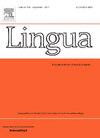语音重叠和同源物在双语语音加工中的作用
IF 1.3
3区 文学
0 LANGUAGE & LINGUISTICS
引用次数: 0
摘要
以往关于中日二语词汇获取的大多数研究都表明,同义词可以促进 L2 日语单词的识别,而语音重叠则不能。然而,本研究的结果对这些结论提出了质疑。在这项研究中,日语水平较高和较低的日语学习者都进行了第二语言的音素监测任务。语音和语义相似度高或低的正字法相似词被完全交叉。我们的研究结果表明,汉语和日语之间的语音重叠干扰了音素处理的速度和准确性,尤其是那些日语水平较低的学习者。然而,随着日语水平的提高,这种抑制作用会逐渐减弱。此外,尽管同义词在音素加工中并不直接发挥作用,但同义词语义重叠与 L2 熟练程度之间存在微弱的相互作用,从而影响音素识别。我们研究的理论意义表明,语音学在掌握两种逻辑语言的二语学习者的语音获取阶段中起着非选择性的作用。此外,跨语系加工并不符合级联模式;相反,二语加工的模块化或交互式模式可以更准确地描述这种加工。本文章由计算机程序翻译,如有差异,请以英文原文为准。
The role of phonological overlap and cognates in dual logographic bilinguals’ phonological processing
Most previous studies on Chinese-Japanese bilingual lexical access have shown that cognates can facilitate L2 Japanese word recognition, and phonological overlap cannot. However, the findings from this research challenge those findings. In this study, both high- and low- proficient JFL (Japanese as a Foreign Language) learners performed phoneme monitoring tasks in their second language. Orthographically similar words with high or low phonological and semantic similarity were fully crossed. Our results suggest that phonological overlap across Chinese and Japanese interferes with phoneme processing speed and accuracy, especially those of the low-proficient JFL learners. Yet as their L2 proficiency improves, this inhibition effect can become smaller. In addition, cognate semantic overlap marginally interacts with L2 proficiency to affect phoneme recognition, though cognates do not directly play a role in phoneme processing. The theoretical implications of our research suggest that phonology functions as a non-selective element in the phonological access phase for bilinguals literate in two logographic languages. Moreover, cross-logographic processing does not conform to the cascading model; instead, it can be more accurately described by the modular or interactive models of bilingual processing.
求助全文
通过发布文献求助,成功后即可免费获取论文全文。
去求助
来源期刊

Lingua
Multiple-
CiteScore
2.50
自引率
9.10%
发文量
93
审稿时长
24 weeks
期刊介绍:
Lingua publishes papers of any length, if justified, as well as review articles surveying developments in the various fields of linguistics, and occasional discussions. A considerable number of pages in each issue are devoted to critical book reviews. Lingua also publishes Lingua Franca articles consisting of provocative exchanges expressing strong opinions on central topics in linguistics; The Decade In articles which are educational articles offering the nonspecialist linguist an overview of a given area of study; and Taking up the Gauntlet special issues composed of a set number of papers examining one set of data and exploring whose theory offers the most insight with a minimal set of assumptions and a maximum of arguments.
 求助内容:
求助内容: 应助结果提醒方式:
应助结果提醒方式:


